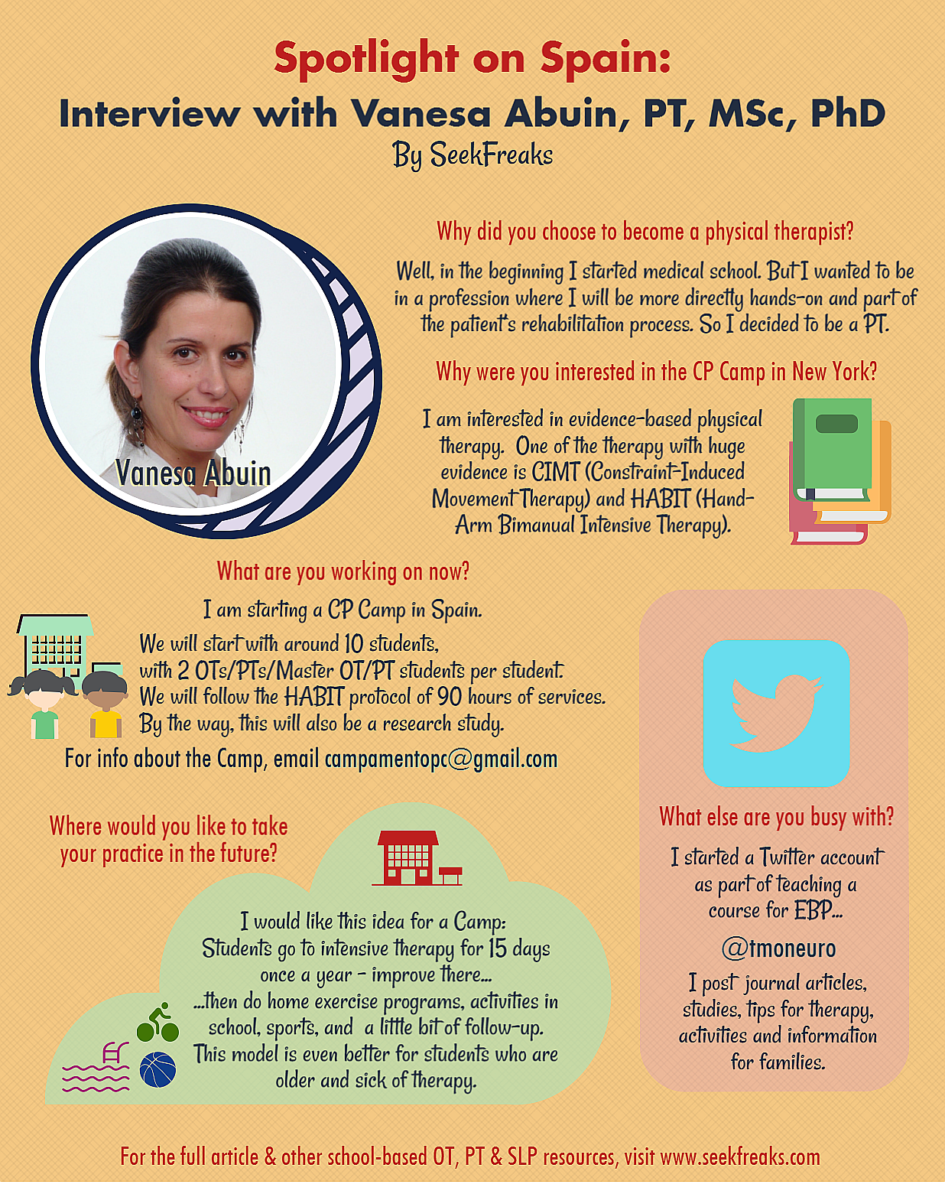[smbtoolbar]
Happy Summer, SeekFreaks! What are you up to? Summer makes me think of vacations, especially some place sunny. So I decided to take all of you to Spain with this interview with Vanesa Abuin, PT, MSc, PhD. She is an adjunct professor in the European University, and a researcher on Musculoskeletal Pain and Motor Control Research Group. We met last year at Dr Andrew Gordon’s CIMT/HABIT/HABIT-ILE Camp at Columbia University in New York. She even translated Motoropoly into Spanish for Spanish-speaking SeekFreaks.
Why did you choose to become a physical therapist?
Well, in the beginning I started medical school. But I wanted to be in a profession where I will be more directly hands-on and part of the patient’s rehabilitation process. So I decided to be a physical therapist.
What are the similarities and differences between the pediatric practice in the US and in Spain?
I feel there are some differences. In the US, you spend a lot of time in assessment. In Spain, the culture is we spend less time in assessment and more in treatment. We usually assess at the start and at the end of the year.
I think the national health system here covers a lot more than in the US. We still feel it’s little, but more than what you have. If you have a kid with disability here, it’s easier to get care of about 1.5 hours a week combination of therapy services.
How does school-based therapy work in Spain?
In mainstream schools our model is more consultation but also treatment. In special education schools, there are more direct treatment.
You were in New York last summer, what were you doing?
I went to Columbia University to work in the CP Camp conducted by Dr. Andrew Gordon. I was recruited by Dr. Victor Santamaria.
Why were you interested in the CP Camp?
I am interested in evidence-based physical therapy. I feel like we are sometimes a bit in the tail of the train of evidence-based practice (EBP). I got my PhD 3 years ago. As a faculty member, we are concerned about EBP. One of the therapy with huge evidence is CIMT (Constraint-Induced Movement Therapy) and HABIT (Hand-Arm Bimanual Intensive Therapy).
Did you have CIMT and HABIT knowledge?
No, but I have a lot of training in motor learning, as my thesis is in that area. I was trained for the CP Camp in the US, then i completed 15 days of training children in the camp using HABIT-ILE (Hand-Arm Bimanual Intensive Therapy Including Lower Extremity). I have never heard of it before, so when they asked me to do it, I said yes!
I saw great improvement in a short period of time. As a conventional therapist, I expected my students to lose some function during holidays, which happens to me here [in Spain] in Easter and Christmas. After the July 4 weekend, none of my kids lost anything. I felt..wow we are changing the brain…neuroplasticity!
The intensity of it shows results. With conventional therapy, child is mixing different therapies (a child here typically goes to different therapists who use different approaches). Because of that you don’t really know what’s working. In the Camp, we know that this is what’s helping. Improvements are due to your intervention.
Now you’re back in Spain. What are you working on?
I returned to working in the clinic, in DACER centre. I’m really interested in the family-centered model that is now spreading in Spain. Families would go to a clinic where the team is going to decide who is the primary therapist model that the family is frequently in contact with, so they won’t have so many different people and treatments around them. Also, during treatment, we talk a lot to the family about what they will be doing at home to empower them. What are their goals, what they want to do?
I am also starting a CP Camp in Spain.
Tell me more about the CP Camp.
First Camp is in July. Right now, lots of paperwork and meetings! I’m really passionate about this project. When you are passionate about something and talk to someone who is interested, it is contagious. I have found interested professionals and families.
I presented at Hemiweb about the Camp, and they are supportive of the Camp. I’ve also found financing for the Camp from DACER Foundation. Dr. Gordon is coming here in the summer to train the volunteers.
We will start with around 10 students, with 2 OTs/PTs/Master OT students/Master PT students per student. We will follow the HABIT protocol of 90 hours of services. The Camp will be in a University, mirroring the protocol we used in Columbia. By the way, this will also be a research study.
Where would you like to take your practice in the future?
I would like this idea for a Camp: Students go to intensive therapy in the Camp for 15 days once a year – improve there, then do home exercise programs, activities in school, sports, and a little bit of follow-up and treatment, but mostly HEP and sports. This model is even better for students who are older and sick of therapy.
What else are you busy with?
I started a Twitter account as part of teaching a course here for EBP. TMO Neurologica is an enterprise/company that promotes evidence-based courses. I teach for them. I run the Twitter account. Three times a week, I post journal articles, studies, tips for therapy, activities (ex. for balance, using an escalator, breaking chocolate), and information for families. When presenting, I talk about theory, but I also talk about how to apply it.
How do you find time to do all of these?
I’m really busy. I love doing all of these!
In case you’ll like more info about the Spanish Camp, write an email to campamentopc@gmail.com










